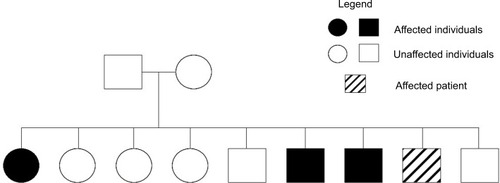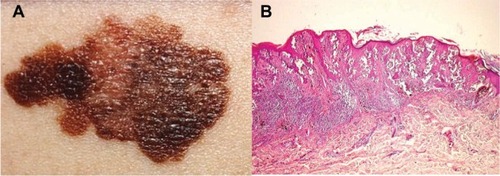Abstract
Xeroderma pigmentosum is a rare autosomal recessive genetic disease characterized by extreme sensitivity due to solar radiation and deficiency in excision repair DNA. Those factors promote a set of skin abnormalities such as keratosis, hyperpigmentation, tumors in areas exposed to sunlight, and ocular and, eventually, neurological disorders. In the present review, we summarize the main clinical features related to a case of xeroderma pigmentosum in a man who was not diagnosed until he was 45 years old.
Introduction
Xeroderma pigmentosum (XP) is a rare autosomal recessive genetic disease, characterized by deficiency in DNA repair mechanism through the nucleotide excision repair (NER) pathway, which leads to sensitivity to ultraviolet (UV) radiation, thereby promoting the appearance of cutaneous tumors, such as squamous cell carcinoma (SCC), basal cell carcinoma (BCC), and cutaneous melanoma (CM).Citation1–Citation3 Approximately 25% of affected individuals have neurologic manifestations like microcephaly, diminished or absent deep tendon stretch reflexes, progressive sensorineural hearing loss, and progressive cognitive impairment.Citation4 The most common cause of death in XP patients is skin cancer, most frequently due to metastatic melanoma or invasive SCC.Citation5 XP patients who smoke have an increased risk of lung cancer compared to the general population, among other cancers, as cigarette smoke components have mutagenic effects similar to UV radiation.Citation5 Skin cancers can also occur in unusual sites that get less UV radiation exposure, including the tongue.Citation6 Studies also suggest that XP patients under age 20 years have increased risk for cancers of the brain and those at other central nervous system locations.Citation7–Citation9
NER is a very important DNA repair pathway as it deals with a wide range of structurally unrelated DNA lesions and adducts. The XP genes (XPA, ERCC3 [XPB], XPC, ERCC2 [XPD], DDB2 [XPE], ERCC4 [XPF], and ERCC5 [XPG]) encode proteins that operate in NER pathway and participate in recognition, demarcation, and removal of DNA damage.Citation10 In addition, XP is associated with pathogenic variants in the DNA bypass polymerase POLH (XPV).Citation10 XP patients harbor mutations in at least 1 of the above genes.Citation11
The incidence of skin cancer is 1,000 times higher in XP patients, and life expectancy is about 30 years. Actually, the median age at death in persons with XP with neurodegeneration (29 years) was found to be lower than that in XP patients without neurodegeneration (37 years).Citation12 Symptoms may begin at 8 years of age when the first lesion may appear.Citation5
This case report comprises an XP patient seen at the Clinical Oncology Service of General Hospital of University of Campinas between 1993 and 2010.
Case report
The study was conducted for educational purposes and according to the Declaration of Helsinki, and it was approved by the Human Ethics Committee of the São Francisco University, Bragança Paulista, SP, Brazil, under protocol no. 49150215.8.0000.5514.
SLJF, a 45 year old, male, Caucasoid, farmer, smoker for 20 years/1 pack a day, sought the oncology department due to an injury in the lower left eyelid accompanied by local pain. During his familial history investigation, the patient reported a sister, 2 brothers, and a cousin with skin cancer (); however, no details were observed in his records. He also mentioned having several tumors in his face since 13 years old, which were surgically removed, irregular use of sunscreen, and daily long period sun exposure. During clinical investigation, hyperchromic and hypochromic spots and many hyperkeratotic papules in sun exposed areas (arms and face) were observed. Therefore, no genetic and histological analysis was performed. We show here, for educational purposes, the SCC and BCC () tumors that were found in the face and wrist of a comparable XP patient. Etretinateretinoid chemopreventive (Tigason®; Hoffmann-La Roche, Basel, Switzerland) was prescribed, which was further replaced by acitretin (Neotigason®; Hoffmann-La Roche), and the mandatory use of sunscreen. The patient was monitored monthly, and at 49 years developed CM in the face. At 50 years, he developed periorbital SCC with the left orbital wall invasion, leading to eye desiccation. At 53 years, new BCC and SCC located in same areas that were previously affected were observed. At 62 years, an inoperable recurrence of CM () was observed. The patient had received Taxol as chemotherapy treatment, but he died after 7 cycles.
Figure 1 Family heredogram showing the patient’s affected family members.
Abbreviation: XP, xeroderma pigmentosum.

Figure 2 Illustrative pictures from a typical ulcerative of BCC and SCC from the face of an XP patient.
Abbreviations: BCC, basal cell carcinoma; H&E, hematoxylin and eosin; SCC, squamous cell carcinoma; XP, xeroderma pigmentosum.

Figure 3 Illustrative pictures from a typical ulceration of CM form the face of an XP patient.
Abbreviations: CM, cutaneous melanoma; H&E, hematoxylin and eosin; XP, xeroderma pigmentosum.

Discussion
The peculiarity of XP is the early onset and is related to severity of lesions, which begin around the age of 2–8 years.Citation5,Citation13 This is justified by alteration in DNA repair capacity after sun exposure, which depending on XP type is reduced to 7.5% or less, compared to 100% in the control group.Citation13 Although our patient had delayed diagnosis of XP, he had an above average survival, probably due to follow-up after diagnosis.
Genetic testing for XP gene mutations and family counseling could help in early diagnostics and aid in assisting family members. Furthermore, the genotypic variety of XP determines the various clinical manifestations observed in the disease.
There is a complex relationship between the clinical diseases and the molecular defects in NER. Patients with one of several clinical diseases may have inherited a defect in one of several different NER genes. Since the NER pathway functions in sequence, a defect in one part of the pathway impairs the function of the subsequent steps.Citation14 Many of the XPA, XPB, XPD, and XPG individuals exhibit a severe NER deficiency,Citation15 whereas individuals with XPV variant show the least aggressive disease, have better prognosis, and enjoy higher life expectancy.Citation1 Also, it appears that individuals who only have a partial NER defect, like XPF and XPC patients, tend not to develop neurologic symptoms at all or develop them later in life as compared with patients with more severe NER defects.Citation15 Our patient did not develop neurologic symptoms and presented ocular issues later in life. Neurological degeneration is observed in 20%–30% of homozygous patients with mutation in XPA or XPD.Citation16 Molecular analyses were not performed in our case, but the diagnosis could be established on a clinical basis.
The public unified health system serves the majority of the Brazilian population. The unified public health system was created by the Brazilian Federal Constitution in 1988, and it is administrated by the Ministry of Health, with subsystems in each Brazilian State and city. However, only in 2014 did the Ministry of Health issue guidelines for complete assistance to be given to individuals with rare disorders.Citation17 Hopefully with these national actions, the scenario presented here might improve and molecular analyses could be performed to help diagnose XP as early as possible.
Consent statement
The authors have tried, unsuccessfully, to obtain written informed consent for publication of this case from the patient’s next of kin. The case has been sufficiently anonymized so as not to cause harm to the patient or their family.
Disclosure
The authors report no conflicts of interest in this work.
References
- ChaibubSCWAlta incidência de xeroderma pigmentosum em comunidade no interior de Goiás. [High incidence of xeroderma pigmentosum in the community of Goias]Surg Cosmet Dermatol201138183
- MiragliaECuratoloPRotunnoRXeroderma pigmentosum: the children of the night. Case report and review of the literaturePrevent Res201224388393
- SoltysDTAnálise da natureza genotípica de pacientes com Xeroderma Pigmentoso brasileiros [tese]. [Analysis of the genotypic nature of Brazilian Xeroderma Pigmentosus patients [thesis]]São Paulo, BrazilInstituto de Ciências Biomédicas, Universidade de São Paulo2010155
- CleaverJECommon pathways for ultraviolet skin carcinogenesis in the repair and replication defective groups of xeroderma pigmentosumJ Dermatol Sci200023111110699759
- DiGiovannaJJKraemerKHShining a light on xeroderma pigmentosumJ Invest Dermatol20121323 Pt 278579622217736
- BradfordPTGoldsteinAMTamuraDCancer and neurologic degeneration in xeroderma pigmentosum: long term follow-up characterises the role of DNA repairJ Med Genet201148316817621097776
- KraemerKHLeeMMAndrewsADLambertWCThe role of sunlight and DNA repair in melanoma and nonmelanoma skin cancer. The xeroderma pigmentosum paradigmArch Dermatol19941308101810218053698
- GiannelliFAveryJPolaniPETerrellCGiammussoVXeroderma pigmentosum and medulloblastoma: chromosomal damage to lymphocytes during radiotherapyRadiat Res19818811942087302127
- DiGiovannaJJPatronasNKatzDAbanganDKraemerKHXeroderma pigmentosum: spinal cord astrocytoma with 9-year survival after radiation and isotretinoin therapyJ Cutan Med Surg1998231531589479081
- RouillonCWhiteMFThe evolution and mechanisms of nucleotide excision repair proteinsRes Microbiol20111621192620863882
- de BoerJHoeijmakersJHNucleotide excision repair and human syndromesCarcinogenesis200021345346010688865
- NetoCFMelanomaBoletim informativo do GBM2003V2014
- Rubió CasadevallJGraña-SuárezBHernandez-YagüeXVayreda RiberaJHucGrasaOBrunet VidalJXeroderma pigmentosum: neck lymph node metastasis of a squamous cell carcinoma of the skin treated with cetuximabEur J Dermatol200919216316519106040
- KraemerKHPatronasNJSchiffmannRBrooksBPTamuraaDDigiovannaaJJXeroderma pigmentosum, trichothiodystrophy and cockayne syndrome: a complex genotype-phenotype relationshipNeuroscience200714541388139617276014
- BootsmaDKraemerKHCleaverJEHoeijmakersJHJNucleotide excision repair syndromes: xeroderma pigmentosum, cockayne syndrome and trichothiodystrophyVogelsteinBKinzlerKWThe Genetic Basis of Human CancerNew York, NYMcGraw-Hill2008245274
- MenckCFMunfordVDNA repair diseases: what do they tell us about cancer and aging?Genet Mol Biol201437Suppl 122023324764756
- Passos-BuenoMRBertolaDHorovitzDDGFerrazVEFBritoLAGenetics and genomics in Brazil: a promising futureMol Genet Genomic Med20142428029125077170
- Wikimedia commons. [webpage on the Internet]Basal Cell Carcinoma Available from https://commons.wikimedia.org/wiki/File:Basal_cell_carcinoma.jpgAccessed May 23, 2018
- Alergodermatoligia. [blog on the Internet] Available from http://alergodermatologia.blogspot.com.br/2008/06/cncer-da-pele.htmlAccessed May 23, 2018
- Wikimedia Commons [webpage on the internet]Basal cell Carcinoma histopathology Available from: https://commons.wikimedia.org/wiki/File:Basal_cell_carcinoma_histopathology_%283%29.jpgAccessed May 23, 2018
- Faculty of Medical Sciences of the State University of Campinas (UNI-CAMP)Pathological Anatomy, Neuropathology and Neuroimaging. [webpage on the Internet] Avaiable from http://anatpat.unicamp.br/Accessed May 23, 2018
- Wikipedia. [website on the Internet] Available from https://pt.wikipedia.org/wiki/Melanoma#/media/File:Melanoma.jpgAccessed May 23, 2018
